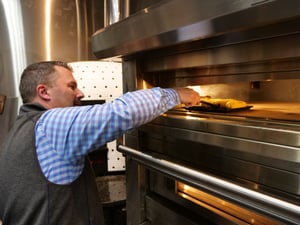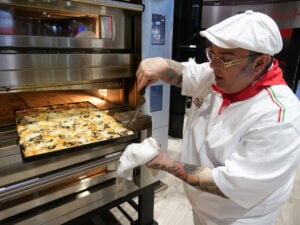
Many of the world’s top chefs and pizzaiolo are converting to commercial electric ovens. That’s because there’s a growing market need for electric high-production baking, space and energy efficiency, and better quality through precise temperature control. In addition, gas fuel and wood-fired are not allowed in all spaces. Recently pizza greats such as John Arena, Chef Leo Spizzirri, and many others made the conversion to using electric ovens. For this reason, and many other reasons, Marra Forni has developed a new modular “ELST” electric deck oven series featuring single-deck through 4 vertically stacked deck ovens. Our Corporate Chef and Culinary Director, Sedrick Crawley, loves the bandwidth of temperature and control that they provide.
Stackable in a client’s restaurant
The ELST Series electric stackable ovens allow Chefs and restauranteurs to vertically optimize precious space to offset sky-rocketing square footage costs in the kitchen. Simple to operate and maintain, these ovens also impact excessive operating and labor costs, we have also responded to the current state of the industry with flexible purchasing plans that enable restaurants to purchase one or two of the ovens at a time and add oven decks as their demand increases and business grows. With the new ELST Stackable Electric Ovens, Marra Forni sets the pace for three primary industry trends with an oven that offers high volume vertically integrated food production, a full range of controllable and sustainable temperatures ranging from 250 degrees F to 950 degrees F, and an energy-efficient solution that complies with the growing demand for green energy and sustainability,” says CEO and Co-founder Francesco Marra.
The development of electric cooking appliances for commercial kitchens is currently in high demand as Green Energy legislation continues to expand across the U.S. By 2030, all new commercial kitchens in the state of California will no longer be allowed to use gas-fired equipment, which is currently the fuel of choice by many foodservice operations. We are committed to the development of new electrical appliances to meet this change in specification and eventual demand. Fortunately for restaurateurs, electric utility costs are projected to be offset by energy rebate programs as well as State and Federal tax incentive programs.
Pinza Roman Pizza Cooked in Stackable Electric Oven

While many pizzerias still like to offer the traditional Neapolitan-style pizza which can be made in 90 While many pizzerias offer the traditional Neapolitan-style pizza which can be made in 90 seconds in the new stackable models, operators continue to expand their menu offerings to include other regional styles of pizza that are typically baked at lower temperatures. Featuring the MarraSmart digital control touchscreen, each individual stackable oven operates using high-efficiency radiant heating technology located within the refractory ceiling and deck brick plates maximizing thermal control for best baking results. “COO and Co-founder Enzo Marra adds, “we have been working on this project for a few years now and we are pleased with the result and we look forward to expanding the product line.”
Cooking Corns in Stackable

The easy to use Marradeck® ovens can be configured as multi-deck using a common chassis, or independently stacked as needed based on production demands. This feature allows new restaurateurs The easy-to-use ELST Series Electric Deck ovens can be configured as a single deck oven or stacked up to four decks in height as needed based on production demands. This unique modular design allows new restaurateurs to build their ovens as they build their businesses. Energy-efficient radiant heat is evenly distributed from all directions, allowing food to cook evenly without the need to rotate the product. The proprietary MarraStone brick tiles are both refractory and porous, supporting highly efficient heat absorption, retention, and distribution to the food. with incredible energy savings. The ovens are designed to offer ideal temperature control which performs efficiently at all temperatures. This added benefit enables pizzerias and restaurants to expand their menu options and even offer additional baked goods such as bread, hot panini, sandwiches, and even pastries.

Since labor is currently less readily available for restaurants, both in terms of skill- level and staffing shortages, relying upon equipment technology to compensate for lack of labor and skill set continues to be an important factor that can make or break the success of a business in our new operating reality.

.jpg?width=366&height=225&name=Untitled%20design%20(79).jpg)
